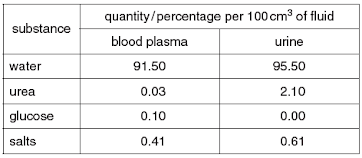IGCSE Past Paper questions on Excretion
1) Where is urea made?
A bladder
B kidney
C liver
D urethra
2) Which function does not occur in the kidneys?
A breakdown of alcohol
B removal of excess salts from the blood
C removal of excess water from the blood
D removal of urea from the blood
3) What is urea formed from?
A amino acids
B fatty acids
C glucose
D glycerol
4) What is the function of the kidney?
A making glucose and reabsorbing urea
B making urea and removing salts
C removing glucose and reabsorbing salts
D removing urea and reabsorbing glucose
4) How does the skin react when the body becomes very warm?
5) Fig. 3.1 shows the excretory system in a human male.
Fig. 3.1
(a) Table 3.1 shows five functions of parts of the excretory system. Complete the table by:
• naming the part that carries out each of the functions
• using the letters from Fig. 3.1 to identify the structures named.
Table 3.1
(b) Urine contains urea.
(i) State where urea is produced in the body.
.......................................................................................................................................[1]
(ii) Name the substance which is broken down to produce urea.
.......................................................................................................................................[1]
Table 3.2 compares the amounts of four different substances in blood plasma and urine.
Table 3.2
(iii) Use the information in Table 3.2 to describe how blood plasma differs from urine.
...........................................................................................................................................
...........................................................................................................................................
.......................................................................................................................................[3] [Total: 10]
6) Urine is a waste product released from the body. It contains urea, water, salts and other metabolic wastes.
A student investigated the chemicals present in different samples of urine, A, B and C. These samples were made up in the laboratory to represent urine. The student carried out a test for protein and a test for reducing sugar on each sample.
(a) Describe the method that the student should use to safely test the samples for:
reducing sugar ...................................................................................................................................................
...................................................................................................................................................
protein. ......................................................................................................................................
................................................................................................................................................... [4]
(b) Table 1.1 shows the student’s observations of the final colour in each of the two tests.
Table 1.1
Urine is often tested as part of a medical health check. The results of these urine tests can be used to suggest whether a person has a health problem.
Assume samples A, B and C were collected from three different people during a medical health check.
If reducing sugar is present, the person may be suffering from a disease called diabetes. If protein is present, the person may be suffering from kidney problems. However, if reducing sugar and protein are both absent from the urine, the person is likely to be healthy.
Use this information to make and explain a conclusion about the health of each of these people.
(i) person A
...........................................................................................................................................
...................................................................................................................................... [2]
(ii) person B
...........................................................................................................................................
...................................................................................................................................... [2]
(iii) person C
...........................................................................................................................................
...................................................................................................................................... [2]
(c) The student decided to test the pH of samples A, B and C using litmus paper. Their teacher suggested that this was not the best way to test the pH and recommended that they used another method.
(i) Describe why the teacher thought that litmus was not suitable. ...................................................................................................................................... [1]
(ii) Suggest a suitable alternative method of determining the pH of a solution.
...................................................................................................................................... [1]
(d) One of the functions of the kidney is to reabsorb glucose back into the blood.
Table 1.2 shows the relationship between the glucose concentration in the blood and the amount of glucose excreted in the urine.
Table 1.2
(i) Plot a graph of the data in Table 1.2.
(ii) Describe the trend shown by the data plotted in (i).
...........................................................................................................................................
...........................................................................................................................................
...................................................................................................................................... [2]
(iii) Use your graph to find how much glucose is excreted in the urine when the blood glucose concentration is 280 mg per 100 cm3.
.................................. mg per minute [1] [Total: 19]
The lungs and the kidneys are excretory organs of the human body.
7(a) (i) Define the term excretion.
...........................................................................................................................................
...........................................................................................................................................
.......................................................................................................................................[3]
(ii) State an excretory product that is passed out through the lungs. ..........................................[1]
(iii) Outline the role of the liver in excretion.
...........................................................................................................................................
...........................................................................................................................................
.......................................................................................................................................[3]
(b) Fig. 4.1 is a vertical section of the kidney.
Table 4.1 shows the functions of parts of the kidney.
Complete the table by:
- naming the part of the kidney that carries out each function
- using letters from Fig. 4.1 to identify the part of the kidney named.
One row has been completed for you.
Table 4.1
(c) People with kidney disease are often treated in renal dialysis clinics. Their blood passes through tubes lined with a special membrane for about three hours.
(i) State two waste substances that are removed from the blood by dialysis.
1 ........................................................................................................................................
2 ........................................................................................................................................ [2]
(ii) Kidney patients may be given a kidney transplant. State one advantage and one disadvantage of kidney transplants compared with dialysis.
advantage ..........................................................................................................................
...........................................................................................................................................
disadvantage .....................................................................................................................
........................................................................................................................................... [2] [Total: 15]











Comments
Post a Comment